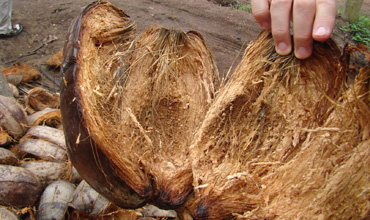Studies on the use of Coconut Fibres as Carrier for Hydrocarbon Degrading Microbes in Remediation of Petroleum Polluted Soil

Abstract:
This study had as its
objective to investigate the characteristics of coconut fibre, from the fruit disposed
in the market place at Effurun, Delta State Nigeria to check the viability of application
of the fibre as carrier for hydrocarbon degrading microorganism. The samples of
the coconut fibre were collected, ground, macerated, sieved and stored. The
particle size, available phosphorus, nitrogen content and moisture content of
the coconut fibres were determined. The results showed that the coconut fibres have
potential related to other natural fibers studied in literature, to be used as
carrier for hydrocarbon degrading microorganisms in remediation of petroleum
polluted soil.
References:
[1.] Agiri, G. O., Akumagba, P. E., Adimula, H. A.,
and Edoga, M. O. (2011) Isolation and Characterization of Petroleum
Hydrocarbons Degrading Bacteria from Soils around Warri, Delta State, Nigeria.
[2.] Ahmedna, M., Marshall W. E, Rao R .M, (2000)
Production of Granular Activated Carbons from select Agricultural by products
and Evaluation of their Physical, Chemical and adsorptive properties.
Bioresource Technol. 71:113-123 .
[3.] Celia, R. C., Regina, A. S., Julia, B. R.,
Jorge, B. (2013) Mechanical Characterization of Green Coconut Fiber for
Application in the Footwear Industry. International Journal of Arts and
Commerce, Vol. 2, No. 9
[4.] Harries, H.(1997) Coconut Palm Encyclopaedia of
Food Science Food Technology and Nutrition. 3rd Edition, Harcourt Brace
Jovanovich Publishers.
[5.] Martins, A. P., Watanabe, T., Silva, P. L R.,
Borelli, C., Marcicano, J. P. P., and Sanches, R. A., (2013).Use of YoungNutCoirFiberforTextileApplicability,RiodeJaneiro:Redigev.4,n.2.
[6.] Saville, B.P., (2007).Physical Testing of Textiles,
Cambridge: The Textile Institute Woodhead Publishing Limited.
[7.] Tam, M., Antal M (1999).Preparation of
Activated Carbons from Macadamia nut shell and Coconut shell by air activation.
Ind. Eng Chem. Res. 38: 4268-4276

